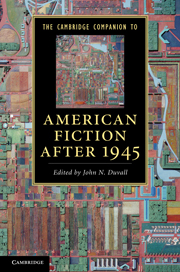Book contents
- Frontmatter
- Introduction: A story of the stories of American fiction after 1945
- PART I POETICS AND GENRES
- PART II HISTORICAL AND CULTURAL CONTEXTS
- 6 African American fiction
- 7 American Indian fiction
- 8 Multiethnicities: Latino/a and Asian American fiction
- 9 American Jewish Fiction
- 10 Feminist fiction
- 11 Southern fiction
- 12 Fiction and the Cold War
- 13 Fiction and 9/11
- PART III MAJOR AUTHORS
- Conclusion: Whither American fiction?
- Index
- Cambridge Companions to …
10 - Feminist fiction
from PART II - HISTORICAL AND CULTURAL CONTEXTS
Published online by Cambridge University Press: 28 March 2012
- Frontmatter
- Introduction: A story of the stories of American fiction after 1945
- PART I POETICS AND GENRES
- PART II HISTORICAL AND CULTURAL CONTEXTS
- 6 African American fiction
- 7 American Indian fiction
- 8 Multiethnicities: Latino/a and Asian American fiction
- 9 American Jewish Fiction
- 10 Feminist fiction
- 11 Southern fiction
- 12 Fiction and the Cold War
- 13 Fiction and 9/11
- PART III MAJOR AUTHORS
- Conclusion: Whither American fiction?
- Index
- Cambridge Companions to …
Summary
At the close of 1979, the New York Times identified “women's lib” as one of the major and defining publishing phenomena of the previous decade. Yet the novel that Times author Ray Walters chose to exemplify this trend, Erica Jong's Fear of Flying (1973), was largely disdained by members of the women's liberation movement that it supposedly represented. Despite the fact that journalists like Walters had no trouble discerning feminist content in the novel, by 1985 Fear of Flying had come to be viewed by many in the movement as “ultimately ‘not feminist’,” according to critic Rosalind Coward. In 1998, however, Lisa Maria Hogeland included Jong's novel in her analysis of women's liberation novels, arguing vigorously that previous analyses had overlooked the novel's genuinely feminist critique of the sexual revolution, and, by 2008, some feminist critics at Columbia University felt positively enough about the novel's politics that they organized a symposium celebrating its thirty-fifth anniversary as a “feminist classic.” Bringing the process full circle, the pop-feminist website Jezebel responded to a report on a family fracas at the conference by debating whether Jong's unsanctioned fictionalization of her sister's marriage in Fear of Flying should be considered an anti-feminist act.
In fact this checkered history suggests that Fear of Flying may indeed be an exemplary American postwar feminist novel, though not precisely in the way meant by the New York Times. Rather, the contentious yet circular trajectory of the discourse surrounding the novel provides a case in point of the myriad literary-critical dilemmas that accompanied the growth of postwar feminist fiction.
- Type
- Chapter
- Information
- The Cambridge Companion to American Fiction after 1945 , pp. 142 - 153Publisher: Cambridge University PressPrint publication year: 2011

